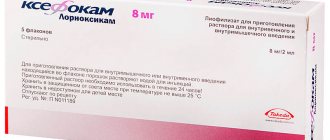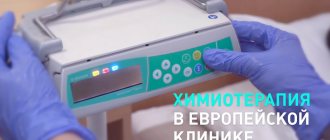Cernevit lyof for the preparation of IV solution N 10
Release form, composition and packaging
Lyophilisate for the preparation of a solution for intravenous administration in the form of a loose solid mass of yellow-orange color, odorless.
| 1 fl. | |
| retinol palmitate (vit. A) | 3500 IU |
| α-tocopherol (Vit. E) | 11.2 IU, |
| which corresponds to the content of D,L-α-tocopherol | 10.2 mg |
| colecalciferol (vit. D3) | 220 IU |
| ascorbic acid (vit. C) | 125 mg |
| cocarboxylase tetrahydrate | 5.8 mg |
| which corresponds to the content of thiamine (vit. B1) | 3.51 mg |
| riboflavin sodium phosphate dihydrate | 5.67 mg, |
| which corresponds to the content of riboflavin (vit. B2) | 4.14 mg |
| dexpanthenol | 16.15 mg, |
| which corresponds to the content of pantothenic acid (vit. B5) | 17.25 mg |
| pyridoxine hydrochloride | 5.5 mg, |
| which corresponds to the content of pyridoxine (vit. B6) | 4.53 mg |
| folic acid (vit. B9) | 414 mcg |
| cyanocobalamin (vit. B12) | 6 mcg |
| Nicotinamide (Vit.PP) | 46 mg |
| biotin (Vit. H) | 69 mcg |
Excipients: glycine - 250 mg, glycocholic acid - 140 mg, soybean phosphatides (soy lecithin) - 112.5 mg, sodium hydroxide - up to pH 5.9, hydrochloric acid - up to pH 5.9.
747 mg - dark glass bottles (10) - plastic contour trays (1) - cardboard boxes.
Clinical and pharmacological group:
Vitamins to be added to parenteral nutrition solutions
Pharmacotherapeutic group:
Multivitamin
pharmachologic effect
Cernevit is a balanced mixture of water-soluble and fat-soluble vitamins. Provides a complete supply of vitamins to the body during parenteral nutrition.
Pharmacodynamic properties are determined by the properties of the vitamins included in the drug.
Vitamin A is involved in the processes of cell growth and differentiation, as well as in the physiological mechanisms of vision.
Vitamin D3 regulates calcium and phosphorus metabolism in bones and kidneys.
Vitamin E is an antioxidant, prevents the formation of toxic oxidation products, protects cellular components.
Vitamin B1 (thiamine) interacts with ATP to form a coenzyme involved in carbohydrate metabolism.
Vitamin B2 (riboflavin) as a coenzyme takes part in cellular energy metabolism, tissue respiration and macronutrient metabolism.
Vitamin B3 (PP), as a component of NAD and NADP coenzymes, is involved in redox processes necessary for the metabolism of macroelements and tissue respiration.
Vitamin B5 (pantothenic acid) is a precursor of coenzyme A, associated with the oxidative metabolism of carbohydrates, gluconeogenesis, the synthesis of fatty acids, sterols, steroid hormones and porphyrins.
Vitamin B6 (pyridoxine) as a coenzyme is involved in the metabolism of proteins, carbohydrates and fats.
Vitamin B12 (cyanocobalamin) is of exogenous origin and is necessary for the synthesis of nucleoproteins and myelin, cell reproduction, normal growth and maintenance of normal erythropoiesis.
Vitamin C (ascorbic acid) is an antioxidant, necessary for the formation and maintenance of intercellular substance and collagen, catecholamine biosynthesis, carnitine and steroid synthesis, folic acid and tyrosine metabolism.
Folic acid is of exogenous origin and is necessary for the synthesis of nucleoproteins and the maintenance of normal erythropoiesis.
Biotin is associated with at least four enzymes and is involved in energy metabolism (including gluconeogenesis).
Pharmacokinetics
In patients receiving Cernevit, plasma concentrations of vitamins A, D, E are restored and maintained at normal levels throughout the period of long-term parenteral nutrition.
Pharmacokinetic properties are determined by the properties of the vitamins included in the drug:
- vitamin A - normal serum level is 80-300 IU/ml, bound to protein, excreted mainly by the kidneys and bile;
- vitamin D - activated in the liver and kidneys by hydroxylation, bound to protein, excreted mainly by the kidneys and bile;
- vitamin E - enters the blood with lipoproteins, is converted into lactone in the liver, and is excreted mainly by the kidneys;
- vitamin B1 (thiamine) - 90% is concentrated in erythrocytes, in plasma it is predominantly bound to albumin, and is excreted mainly by the kidneys;
- vitamin B2 (riboflavin) - in plasma binds to proteins, the level of vitamin in plasma can vary greatly, is excreted mainly by the kidneys in an unbound form or in the form of metabolites;
- vitamin B3 (PP) - exists in the plasma in the form of acid and amide, excreted by the kidneys in an unbound form or in the form of metabolites;
- vitamin B5 (pantothenic acid) - exists in unbound form or in the form of vitamin A in plasma and red blood cells, excreted by the kidneys;
- vitamin B6 (pyridoxine) - metabolized in the liver and excreted by the kidneys;
- vitamin B12 (cyanocobalamin) - normal serum level is 200-900 pg/ml, binds to proteins, accumulates in the liver, is found in milk, 50-90% is excreted by the kidneys;
- vitamin C (ascorbic acid) - at normal concentrations (8-14 mg/l) is completely absorbed by the kidneys, excess is excreted by the kidneys;
- folic acid - normal plasma concentrations are 0.005-0.015 mcg/ml, distributed to all tissues, metabolized and accumulated in the liver, at high levels maximum renal reabsorption prevails, excreted by the kidneys;
- biotin - exists in plasma in free form or in protein-bound form, and is excreted by the kidneys mainly unchanged.
Indications
- an addition to parenteral nutrition for the prevention of hypo- and vitamin deficiencies for adults and children over 11 years of age.
Dosage regimen
The drug is intended for intravenous administration only.
The recommended dose is 5 ml (1 bottle)/day.
Cernevit can be used during the entire period of parenteral nutrition. Duration of use - in accordance with the doctor's prescription.
Rules for preparing and administering the solution
Using a syringe, 5 ml of water for injection or a 5% dextrose (glucose) solution, or a 0.9% sodium chloride solution is injected into the vial. Stir carefully until the lyophilisate is completely dissolved. The resulting solution has a yellow-orange color.
The resulting solution is slowly injected intravenously (over at least 10 minutes).
The drug solution can be added to two-component (glucose solution with electrolytes and amino acids) or three-component (glucose solution with electrolytes, amino acids, fat emulsion) solutions for parenteral nutrition, subject to compatibility.
Before use, check the integrity of the packaging.
Aseptic conditions must be observed.
Do not store the bottle with unused remains of the drug or with a drug whose color after dissolution does not correspond to the description.
Side effect
Allergic reactions: since the drug contains vitamin B1, anaphylactic reactions rarely (> 1/10,000 - < 1/1000) develop in patients with delayed-type allergies.
The patient should inform the doctor of any side effects that occur.
Contraindications for use
- children under 11 years of age;
- hypersensitivity to the components of the drug, especially to vitamin B1.
Relative contraindication: concomitant use of levodopa drugs.
Use during pregnancy and breastfeeding
Since there are no data from clinical studies on the use of Cernevit in pregnant women, the drug should not be prescribed during pregnancy.
The use of the drug during lactation is not recommended, since vitamins are excreted in breast milk.
Use for liver dysfunction
Due to the presence of glycocholic acid as an excipient, with repeated and long-term administration of the drug in patients with jaundice or severe cholestasis (changes in laboratory liver function tests), liver function must be carefully monitored.
Use in children
Contraindication: children under 11 years of age.
special instructions
Due to the presence of glycocholic acid as an excipient, with repeated and long-term administration of the drug in patients with jaundice or severe cholestasis (changes in laboratory liver function tests), liver function must be carefully monitored.
Deficiency of one or more vitamins should be corrected by administering a preparation of the missing vitamin.
Cernevit does not contain vitamin K, which can be administered separately if necessary.
After dilution, the drug is stable at a temperature not exceeding 25°C for 24 hours, but it is recommended to use the drug immediately after dilution or store it for no more than 24 hours at a temperature of 2° to 8°C.
Impact on the ability to drive vehicles and operate machinery
Since Cernevit is intended for patients receiving parenteral nutrition and in severe to moderate condition, the ability to drive a car and operate machinery was not assessed.
Overdose
Overdose is predominantly caused by excessive doses of vitamin A.
Symptoms: in case of acute overdose of vitamin A (doses exceeding 150,000 IU) - gastrointestinal disorders, headache, increased intracranial pressure, papilledema, mental disorders, excitability, sometimes convulsions, delayed generalized desquamation of the epithelium; with chronic overdose of vitamin A - increased intracranial pressure, cortical hyperostosis and premature fusion of the epiphyseal plate, which is usually expressed in the occurrence of sensitive or painful subcutaneous swelling on the fingers of the upper and lower extremities. On radiographic examination, diaphyseal periosteal thickenings are noticeable on the ulna, fibula, clavicular and costal bones.
Treatment: stop using the drug, reduce calcium intake, increase diuresis and adequately rehydrate the body.
Drug interactions
Due to the presence of pyridoxine (vitamin B6) in the drug, combined use with levodopa drugs is contraindicated due to the acceleration of the metabolism of levodopa with the participation of a pyridoxine-dependent enzyme. To prevent this interaction, you can use the dopa decarboxylase inhibitor, carbidopa.
Due to the presence of folic acid in the drug, caution should be exercised when used together with antiepileptic drugs containing phenobarbital, phenytoin or primidone. Clinical observation and, if possible, monitoring of the content of antiepileptic drugs in the blood plasma, correction of the dosage regimen of the antiepileptic drug during and after stopping the use of folic acid are necessary.
Compatibility should be checked when preparing with other solutions for infusion, especially if Cernevit is added to binary parenteral mixtures containing glucose, electrolytes and amino acid solutions or to mixtures containing glucose, electrolytes, amino acid solutions and lipids.
The patient should inform the doctor about any medications that have been used previously.
Conditions for dispensing from pharmacies
The drug is available with a prescription.

